
Coloureds refers to members of multiracial ethnic communities in Southern Africa who may have ancestry from more than one of the various populations inhabiting the region, including African, Asian, as well as European. South Africa's Coloured people are regarded as having some of the most diverse genetic background. Because of the vast combination of genetics, different families and individuals within a family may have a variety of different physical features.

The katipō is an endangered species of spider native to New Zealand. It is one of many species in the genus Latrodectus, such as the Australian redback, and the North American black widow. The species is venomous to humans, capable of delivering a potentially dangerous bite. It is a small to medium-sized spider, with the female having a round black or brown pea-sized body. Red katipō females, found in the South Island and the lower half of the North Island, are always black, and their abdomen has a distinctive red stripe bordered in white. In black katipō females, found in the upper half of the North Island, this stripe is absent, pale, yellow, or replaced with cream-coloured blotches. These two forms were previously thought to be separate species. The male is much smaller than the female and quite different in appearance: white with black stripes and red diamond-shaped markings. Katipō are mainly found living in sand dunes close to the seashore. They are found throughout most of coastal New Zealand except the far south and west. Katipō feed mainly on ground dwelling insects, caught in an irregular tangled web spun amongst dune plants or other debris.

Eurema hecabe, the common grass yellow, is a small pierid butterfly species found in Asia, Africa and Australia. They are found flying close to the ground and are found in open grass and scrub habitats. It is simply known as "the grass yellow" in parts of its range; the general term otherwise refers to the entire genus Eurema.

Belenois aurota, the pioneer or pioneer white or caper white, is a small to medium-sized butterfly of the family Pieridae, that is, the yellows and whites, which is found in South Asia and Africa. In Africa, it is also known as the brown-veined white, and is well known during summer and autumn when large numbers migrate north-east over the interior.
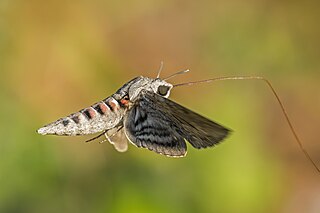
Agrius convolvuli, the convolvulus hawk-moth, is a large hawk-moth. It is common throughout Europe, Asia, Africa, Australia and New Zealand, partly as a migrant. In New Zealand, it is also known as the kumara moth, and in the Māori language as hīhue.
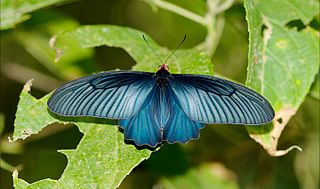
Atrophaneura varuna, the common batwing, is a butterfly found in India and Southeast Asia that belongs to the swallowtail family, and more specifically, the batwings group of Atrophaneura, comprising tailless black swallowtail butterflies.

The Australian ringneck is a parrot native to Australia. Except for extreme tropical and highland areas, the species has adapted to all conditions. Treatments of genus Barnardius have previously recognised two species, the Port Lincoln parrot and the mallee ringneck, but due to these readily interbreeding at the contact zone they are usually regarded as a single species B. zonarius with subspecific descriptions. Currently, four subspecies are recognised, each with a distinct range.

The pink robin is a small passerine bird native to southeastern Australia. Its natural habitats are cool temperate forests of far southeastern Australia. Like many brightly coloured robins of the family Petroicidae, it is sexually dimorphic. Measuring 13.5 cm (5.3 in) in length, the robin has a small, thin, black bill, and dark brown eyes and legs. The male has a distinctive white forehead spot and pink breast, with grey-black upperparts, wings and tail. The belly is white. The female has grey-brown plumage. The position of the pink robin and its Australian relatives on the passerine family tree is unclear; the Petroicidae are not closely related to either the European or American robins, but appear to be an early offshoot of the Passerida group of songbirds.

The rose robin is a small passerine bird native to Australia. Like many brightly coloured robins of the Petroicidae, it is sexually dimorphic. The male has a distinctive pink breast. Its upperparts are dark grey with white frons, and its tail black with white tips. The underparts and shoulder are white. The female is an undistinguished grey-brown. The robin has a small black bill and eyes.

Correa alba, commonly known as white correa, is a species of shrub that is endemic to south-eastern Australia. It has egg-shaped to more or less circular leaves, erect white flowers arranged singly or in groups on short side branches, and green fruit.

Corymbia terminalis, also known as tjuta, joolta, bloodwood, desert bloodwood, plains bloodwood, northern bloodwood, western bloodwood or the inland bloodwood, is a species of small to medium-sized tree, rarely a mallee that is endemic to Australia. It has rough, tessellated bark on some or all of the trunk, sometimes also on the larger branches, smooth white to cream-coloured bark above, lance-shaped adult leaves, flower buds in groups of seven, white flowers and urn-shaped fruit.
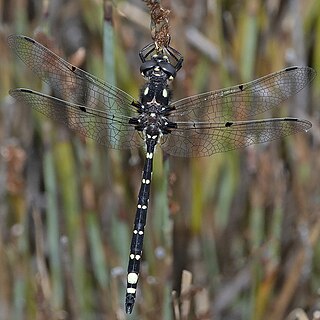
Synthemiopsis gomphomacromioides, also known as the Tasmanian spotwing, is a species of dragonfly from southern and north-western Tasmania, Australia. It is the only species in the genus Synthemiopsis and has also been placed in its own tribe, Synthemiopsini. R. J. Tillyard, who first described it, considered it intermediate between the Australian genus Synthemis and the Chilean Gomphomacromia. He had material from swamps around Cradle Mountain, at about 4,000 feet (1,200 m) altitude, and from Flowerdale Creek near Wynyard. Synthemiopsis gomphomacromioides flies rapidly over the swamps and often sits on reeds. It occurs together with Synthemis tasmanica, a similar but duller-coloured species.
Ectopatria virginea is a moth of the family Noctuidae. It is found in South Australia.

Creatonotos gangis is a species of arctiine moth in South East Asia and Australia. It was described by Carl Linnaeus in his 1763 Centuria Insectorum.
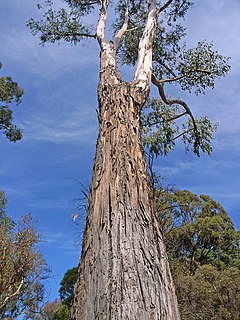
Eucalyptus dunnii, commonly known as Dunn's white gum or simply white gum, is a species of medium-sized to tall tree that is endemic to eastern Australia. It has rough bark near the base, smooth white to cream-coloured bark above, lance-shaped to curved adult leaves, flower buds in groups of seven, white flowers and cup-shaped, conical or hemispherical fruit.

Eucalyptus roycei, commonly known as Shark Bay mallee, is a species of mallee or a small tree that is endemic to a small area along the Gascoyne coast of Western Australia. It has rough fibrous or flaky bark on the lower trunk, smooth greyish bark above, lance-shaped to curved adult leaves, flower buds in groups of seven or nine, cream-coloured or pale yellow flowers and cylindrical to barrel-shaped, four-sided fruit.

Eremophila santalina is a flowering plant in the figwort family, Scrophulariaceae and is endemic to South Australia. It is an erect, glabrous shrub with thin branches, flexible leaves and white or cream-coloured flowers which sometimes have a slight pinkish-purple tinge.
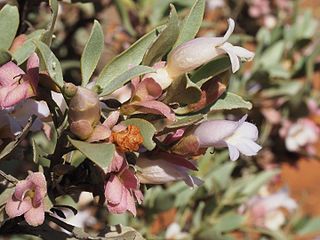
Eremophila tietkensii is a flowering plant in the figwort family, Scrophulariaceae and is endemic to Australia. It is a rounded to flat-topped shrub with grey-green leaves, usually pinkish-purple sepals and mauve, pink or lilac-coloured petals. It is mostly found in Western Australia but also occurs in the far west of the Northern Territory.

Eucalyptus whitei, commonly known as White's ironbark, is a eucalypt that is native to Queensland.
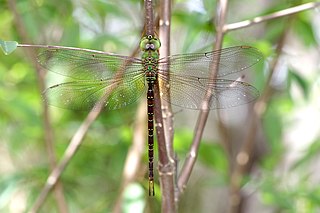
Gynacantha rosenbergi is a species of dragonfly in the family Aeshnidae, known as the grey duskhawker. It inhabits still waters and is found in New Guinea, Indonesia, through parts of northern Australia, as well as islands in the south Pacific.


















